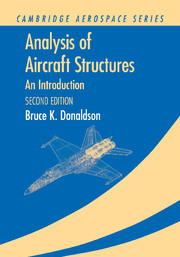Book contents
- Frontmatter
- Contents
- Introduction to the Second Edition
- Introduction to the First Edition
- List of Repeated Engineering Symbols
- Acknowledgments
- Part I The Fundamentals of Structural Analysis
- Part II **Introduction to the Theory of Elasticity**
- Part III Engineering Theory for Straight, Long Beams
- Part IV Work and Energy Principles
- Part V Energy-Based Numerical Solutions
- 16 **Precursor Numerical Analyses**
- 17 Introduction to the Finite Element Method
- 18 Finite Element Truss Problems
- 19 Basic Aspects of Multidimensional Finite Elements
- 20 The Unit Load Method for Determinate Structures
- 21 The Unit Load Method for Indeterminate Structures
- Parts IV and V Review Questions
- Part VI Thin Plate Theory and Structural Stability
- Appendix A Additional Topics
- Appendix B Selected Answers to Exercises
- References
- Index
18 - Finite Element Truss Problems
from Part V - Energy-Based Numerical Solutions
Published online by Cambridge University Press: 05 June 2012
- Frontmatter
- Contents
- Introduction to the Second Edition
- Introduction to the First Edition
- List of Repeated Engineering Symbols
- Acknowledgments
- Part I The Fundamentals of Structural Analysis
- Part II **Introduction to the Theory of Elasticity**
- Part III Engineering Theory for Straight, Long Beams
- Part IV Work and Energy Principles
- Part V Energy-Based Numerical Solutions
- 16 **Precursor Numerical Analyses**
- 17 Introduction to the Finite Element Method
- 18 Finite Element Truss Problems
- 19 Basic Aspects of Multidimensional Finite Elements
- 20 The Unit Load Method for Determinate Structures
- 21 The Unit Load Method for Indeterminate Structures
- Parts IV and V Review Questions
- Part VI Thin Plate Theory and Structural Stability
- Appendix A Additional Topics
- Appendix B Selected Answers to Exercises
- References
- Index
Summary
Introduction
The use of a separate chapter for truss problems is prompted by the convenience of using the simpler bar element, as opposed to the beam element, as a means of illustrating the following topics that are less vital to an overall understanding of the basics of the FEM: (i) bars (or beams, or whatever) that are neither horizontally nor vertically oriented so that the element DOF are rotated relative to the global DOF; (ii) the equivalent loads that arise from enforced boundary deflections; and (iii) the equivalent loads that arise as a result of temperature changes or other initial strains. For the sake of simplicity, the developments of this chapter will be kept within the confines of planar trusses. The only slightly more complicated geometry of three-dimensional structures, which is available in all major commercial programs, is not necessary to the development of the reader's understanding of the concepts to be explored here. However, the bar element in three dimensions is adequately introduced in Exercise 18.10(b).
Bar elements do not differ much from beam elements. A distinction is usually made in a commercial FEM program between a beam and a bar in order to use the simpler bar element formulation wherever possible. It can be expected that any such program offers a beam element that includes the axial deformation properties of a bar. That is, there is always available a beam element with six DOF at each beam end, for a total of 12 DOF.
- Type
- Chapter
- Information
- Analysis of Aircraft StructuresAn Introduction, pp. 602 - 622Publisher: Cambridge University PressPrint publication year: 2008



